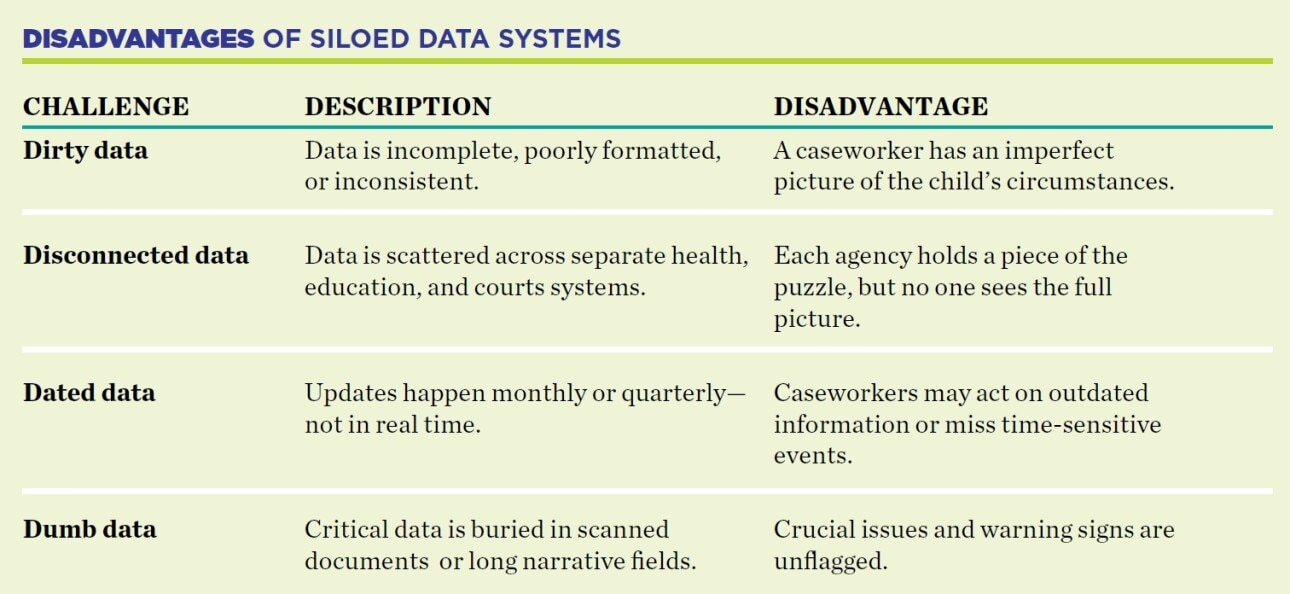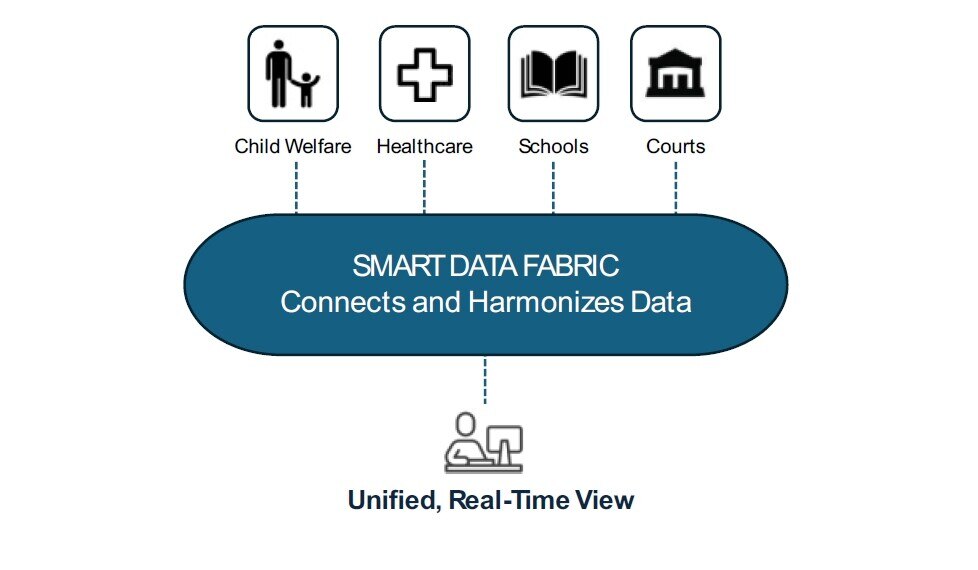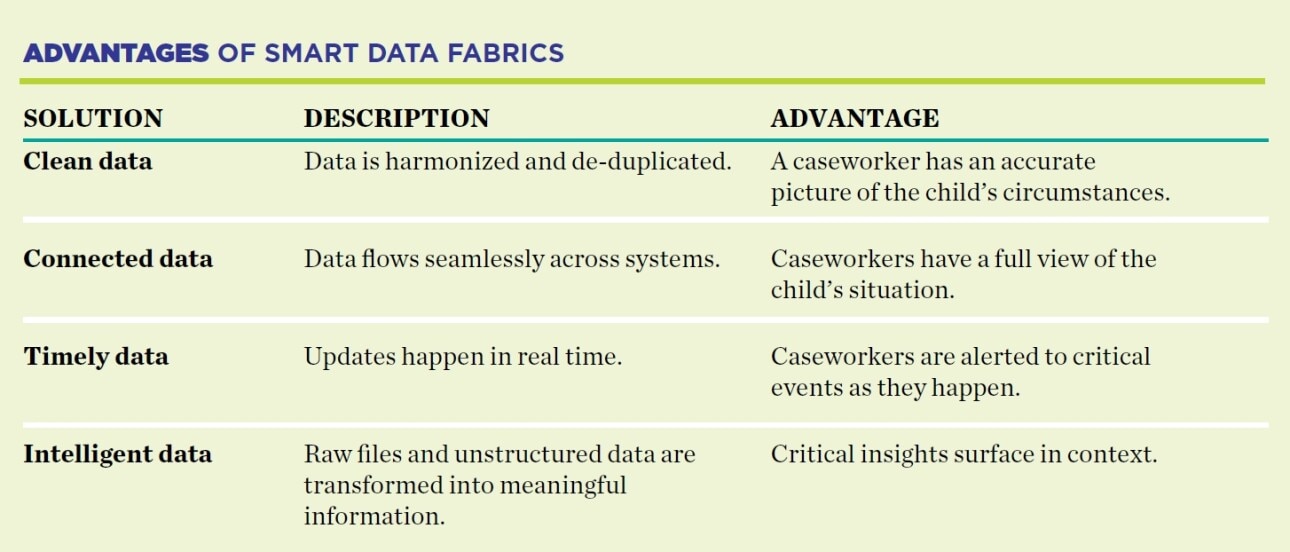Child welfare in the U.S. is evolving. Fewer children are entering foster care than in the past, and agencies have become far more effective at keeping families together. This progress is a testament to the dedication of child welfare professionals and the growing emphasis on prevention of abuse and neglect, and on family preservation. But the children who do enter care today tend to have the most complex needs. Many of them face co-occuring behavioral, medical, or social challenges that are handled by multiple government agencies.
Helping children thrive requires more than commitment and compassion. Caseworkers must have complete and accurate information to take timely, appropriate actions. But essential case data is often scattered across different agency systems, making it difficult to form a clear picture of a child’s circumstances.
Fortunately, there is a way to link data, empower caseworkers, and better serve children. Smart data fabrics can help child welfare agencies bridge information silos, increase insights, and improve outcomes.
Child Welfare Needs a Fresh Approach to Data
Over the past decade, governments have poured billions into modernizing child welfare data systems. Initiatives like the Comprehensive Child Welfare Information System (CCWIS) were intended to significantly improve case management and compliance reporting. But one fundamental issue remains: essential data isn’t always where it needs to be, when it’s needed. And in child welfare, that isn’t just frustrating, it’s dangerous to children.

into a unified, real-time view.
The Challenge: Dirty, Disconnected, Dated, and Dumb Data
Siloed data systems hamper caseworkers and adversely affect the care children receive. Caseworkers routinely spend hours manually gathering and reconciling disparate data from different sources. All too often, critical warning signs like a missed medical appointment or a sudden drop in school attendance slip through the cracks. The problem isn’t a lack of data, but its accessibility and quality. The data exists, but it is often dirty, disconnected, dated, and dumb. And the more time workers spend chasing down data, the less time they spend delivering services to children.
Real-World Consequences
Consider a child with complex behavioral and medical needs who’s waiting in a hospital bed for a specialized placement. A spot is available, but it takes days or even weeks to gather the necessary records from separate health, education, and child welfare systems. During that time, the child’s trauma deepens.
Think about a student in foster care who begins skipping school—an indicator of larger potential problems. Because attendance data is only shared quarterly, no one notices until months later, by which time the child has fallen far behind and problems have grown.
Imagine a medical alert about a child’s seizure disorder, buried deep in a scanned PDF. No one spots it in time to prevent a crisis.
The bottom line: all the data is there, but it’s incredibly difficult for caseworkers to piece it all together. And when important information is overlooked, children often suffer.
The Solution: A Smart Data Fabric
Forward-looking agencies are adopting a data-first mindset and introducing smart data fabrics to streamline information follows, increase insights, and improve results. A data-first approach means prioritizing data and data governance from the onset. It means investing in data quality, dictionaries, and standards so information is consistent across systems, and focusing on understanding what data is needed and how it can be used to improve child safety and outcomes.
A smart data fabric is a modern data architecture that weaves together information from many systems—child welfare, healthcare, schools, courts, and others—into a unified, real-time view. A smart data fabric doesn’t replace existing systems. It links them together, allowing data to flow freely while remaining in its original location. A smart data fabric cleans and unifies the data, making it usable and meaningful. It identifies, extracts, and distills critical information to enable better, faster decisions. And it enforces access controls to protect data privacy and help with regulatory compliance.

A smart data fabric delivers what child welfare agencies urgently need: accurate, connected, timely, and intelligent data that is informative, actionable, and reliable. This technology is tried, trusted, and available today.

Summary
Smart data fabrics help child welfare organizations increase insights, improve decisions, and deliver better results for children and families. Caseworkers can’t fix what they can’t see. A smart data fabric helps them see the full picture!
Contact us to learn how InterSystems can help your organization create a smart data fabric.


























